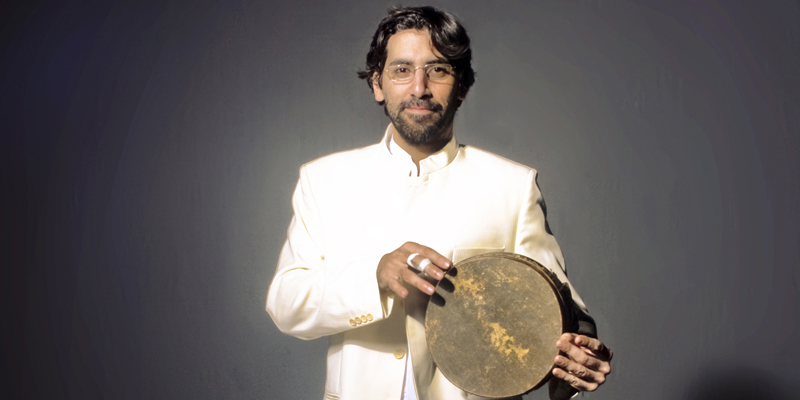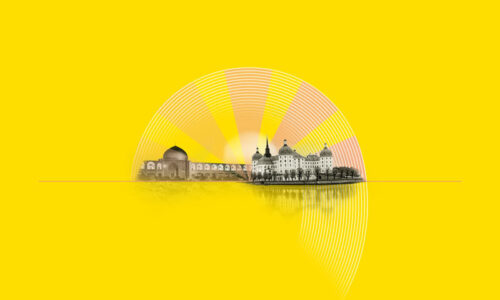27 February 2019

The legacy of the visit of theatre-maker Peter Brook to Glasgow 30 years ago, with his epic staging of The Mahabharata, for which the Tramway venue was created in the run-up to the city’s year as European Capital of Culture in 1990, resonates to this day.
Following the return appearance by dancer and choreographer Akram Khan, a member of the cast as a boy in 1988, to the city last summer, alongside a residency by Brook’s Theatre des Bouffes du Nord at the 2018 Edinburgh Festival, now in 2019, Scottish Ensemble are working with another Paris-based artist whose family connections to Scotland date back to that memorable production.
The cross-cultural group that provided all the music for The Mahabharata included Keyvan and Bijan’s father, the zarb virtuoso Djamchid Chemirani. Now in his mid-70s and still performing, Djamchid toured the world with the Brook show, and also played on the film version.
But as Keyvan explains, his – and his family’s – expertise goes to the source of the modern use of the instrument that they now play with musicians from cultures around the globe, as well as jazz and classical Baroque players.
“My father learned from a master of the zarb in Iran, Ostad Hossein Tehrani, who took the instrument from a supporting role to that of a soloist, with a whole range of different sounds and expression. My father was his best student and was often on television and radio in Iran.”
Keyvan explains that the Eastern way of learning an instrument is to spend ten or fifteen years in the close company of a master, learning all his techniques by ear. “After that, you start to fly and find your own way.”
Djamchid left Iran before the revolution in 1979 to further his studies of mathematics in France, but also continued as a musician, and that path has been followed step by step by his son. Born in Paris, and brought up in Provence, he has a degree in mathematics while his father has been his master in the study of the zarb, alongside which Keyvan also plays the North Indian santoor, an instrument like a cimbalom or hammered dulcimer, whose origins are also lost in antiquity.
“They are both very ancient. It’s very difficult to say, but they’re at least 500 years old, and could be older – and the zarb is still the most popular Persian instrument.”
Few play it with the facility of Keyvan Chemirani, however, who says that the disciplines of mathematics and “digital percussion” – that is, percussion instruments played only with the fingers, rather than beaters or hammers – are closely related. Although his father was his only teacher of Iranian percussion, Keyvan then pursued his studies in India, adding to his techniques from the huge repertory of music there.
It was Djamchid, however, who had already shown his son how those skills could be combined with those of other musicians with very different training: “He has been open to playing with jazz and classical musicians as well as improvising with African musicians.”
Keyvan sees many parallels between the classical music of India, Turkey and Iran and Western Baroque music.
“They were all created to be played for princes and kings and to a small audience. The music is spiritual and deep and designed for a small room – chamber music. The sound of the instruments is not very powerful, but warm and delicate, and part of the art is to develop skill in ornamentation, often to support the voice of a singer and the lyrics.”
At the same time, there are significant differences, but he sees these as only as enhancing the opportunities in collaboration. “Eastern music is modal, which is very different from Baroque harmony, but it’s still possible to find common ground, while celebrating the differences. You have to use the legacy you have. It should not be smooth and gentle!”
Learning to improvise, he says, is integral to the process of tuition with an Eastern master, and acquired at the same time as technique – something that is still not always such an an essential part of training to those in the Western classical tradition.
“That is changing now. A lot of classical musicians know how to play jazz and improvise, but I think it’s quite new. And the opposite is also true; there are now Eastern musicians who read music well, and that’s also a new thing.”
Keyvan’s own practice now knows no boundaries. The family Trio Chemirani continues, where he and his father are joined by brother Bijan and sometimes accompany his sister Maryam, singing ancient Persian poetry whose rhythms are integral to the music of the tradition.
In another trio, Keyvan works with French harpsichord player Jean Rondeau and Paris-based lutenist Thomas Dunford, and when the new director of the British Museum, Hartwig Fischer, animated his galleries with “A Symphony of Cultures” in April, he was a member of the Montreal-based international group, Ensemble Constantinople.
He has recorded for the jazz and classical label ECM with French clarinettist Louis Sclavis and appeared at Glasgow’s Celtic Connections in the “Projekt” of French flautist Sylvian Barou.
Bassist Renaud Garcia Fons, Irish traditional musician Donal Lunny and Scottish harpist Savourna Stevenson have all shared stages with him around the world, and it was in Adelaide that he met his wife Laube when she was a backing singer with Congolese musician Papa Wemba.
As for Continental Drift, two brothers will be joined by Sokratis Sinopoulos on lyra, a Greek fiddle. From their first conversations, both Keyvan and Jonathan Morton were united in their desire to approach the collaboration without any preconceptions.
“When I met with Jonathan, he was very open-minded about what we might do. All three of the trio - myself, my brother and Sokratis – have compositions, with room for a lot of improvisation, and there will be some Baroque music as well. It’ll be exciting to find out where it takes us.”
